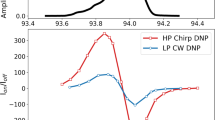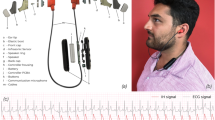Abstract
THE principal expense and source of difficulty in equipment for nuclear magnetic resonance is the magnet to provide the large magnetic field. It has been shown that a nuclear-resonance signal can be obtained using only the Earth's field1,2. This is the so-called free-precession experiment, in which the nuclear system is first polarized at right angles to the Earth's field by means of a simple current-carrying coil. After removal of this field, the nuclear magnetization precesses about the Earth's field (approximately 0.48 gauss) and induces an alternating voltage in the same coil at a frequency of about 2 kc./s., which may be observed after suitable amplification. The polarizing field serves the double purpose of producing a nuclear magnetization appropriate to a large field and hence a stronger signal to be observed in the smaller field, and also produces this polarization at right angles to the small field. The signal is attenuated by loss of phase-coherence of the precessing nuclei, due both to interactions between them with a time constant T 2, and to inhomogeneity in the Earth's field (T 2 *). The method can be used for measuring the decay time, T 2, which is a property of the material, by observing the decay of the precession signal, provided the inhomogeneity of the Earth's field is sufficiently small for T 2 * ≫ T 2. In many cases, for example, in liquids such as water containing mobile protons, T 2 may be several seconds and the corresponding field mhomogeneity must be less than 10 microgauss/cm. in order to measure T 2. This implies that the experiment cannot be performed in the laboratory and usually requires the sample coil to be placed out of doors away from all buildings (we have found a brick wall to be unacceptably magnetic in this sense).
This is a preview of subscription content, access via your institution
Access options
Subscribe to this journal
Receive 51 print issues and online access
$199.00 per year
only $3.90 per issue
Buy this article
- Purchase on Springer Link
- Instant access to full article PDF
Prices may be subject to local taxes which are calculated during checkout
Similar content being viewed by others
References
Packard, M., and Varian, R., Phys. Rev., 93, 941 (1954).
Waters, G. S., and Phillips, G., Geophysical Prospecting, 4, No. 1 (1956).
Hahn, E. L., Phys. Rev., 80, 580 (1950).
Giulotto, L., Arch. Sci., 9, Report of 5th Colloque AMPERE, p. 218 (1956).
Waters, G. S., and Francis, P. D., S.R.D.E. Report No. 1097 (Ministry of Supply, Oct. 1955).
Author information
Authors and Affiliations
Rights and permissions
About this article
Cite this article
POWLES, J., CUTLER, D. Audio-frequency Nuclear-resonance Echoes. Nature 180, 1344–1345 (1957). https://doi.org/10.1038/1801344a0
Issue Date:
DOI: https://doi.org/10.1038/1801344a0
Comments
By submitting a comment you agree to abide by our Terms and Community Guidelines. If you find something abusive or that does not comply with our terms or guidelines please flag it as inappropriate.



